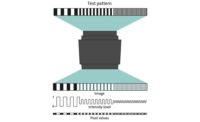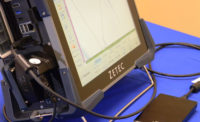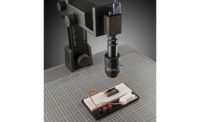Understand Tradeoffs to Maximize Lens Performance
The machine vision system is only as good as its lens.

The temptation when choosing a lens for a machine vision system is to want more of everything—resolution, field of view, temperature range—because the system is only as good as its lens. Unfortunately, increasing lens performance usually increases one or more of size, weight, and cost. This article examines some tradeoffs encountered when choosing a lens, then considers when a custom-designed lens might be the right choice.
For purposes of this article, the following definitions apply:
- An element is a single piece of curved, polished glass used in a lens. A lens is a combination of elements with mechanical components to hold the elements in the correct orientation.
- The surfaces of spherical elements are sections of spheres. The surfaces of aspherical elements, which are considerably more difficult to manufacture, have slight departures from sphericity.
- Resolution is the ability of the lens to distinguish features separated by a small distance (or small angle). Higher resolution means that smaller features, closer together, can be distinguished. (The increase in pixel count in digital sensors is driving demand for higher resolution lenses.)
- Field of View (FOV) is that portion of the object for which the lens forms an image onto the sensor. Field of view can be defined as an area or as an angular extent. (A larger sensor requires a larger FOV.)
- Back Working Distance is the distance from the last surface of the lens to the image plane.
- Optical Speed is a measure of the light gathering ability of the lens. A lens with lower f-number is said to be faster than a lens with a higher f-number.
- Wavelength Range is that portion of the spectrum of light over which the lens provides the desired performance. (The popularity of LEDs drives demand for lenses with good performance in deep blue wavelengths.)
- Shock and Vibration Resistance is the ability of the lens to perform while (or after) being subjected to mechanical shock and vibration.
- Operating Temperature Range is the lower and upper temperature limits between which the lens is required to perform.
The arrows in the table on the previous page shows the change in size, weight, and cost of a lens that one should expect when the parameter in the far-left column is increased, with all other parameters held equal. A zero indicates no significant change. If a parameter in the left column were decreased, then the arrows in that row would reverse direction while the zeros would remain zeros.
Two caveats apply: First, these tendencies are rules-of-thumb, not absolutes. Exceptions exist, especially when a clever designer looks for them. Second, it is rare that only one parameter at a time would be changed and all others held equal. A change to a lens design would usually include changes to multiple parameters at the same time.
Focal length is a special case. A lens design generally becomes more complex if the lens size stays constant while focal length increases. On the other hand, lens complexity also increases if back working distance is held equal but focal length is decreased. Increased complexity almost always results in a more expensive lens.

Designers of catalog lenses try to balance these performance and expense trade-offs in a way that works for a range of applications. The customer must then search for the best available combination of performance, size, weight, and cost.
Particularly demanding applications may justify a custom lens. A good designer can help ensure that a customer pays for the performance he or she wants without also paying for performance that is not needed.
Catalog lenses will always be cheaper than custom lenses, but for some combinations of performance requirements and production quantities a custom lens will be a better value. Specifications such as constrained size, light weight, ruggedness, extended wavelength range, or low distortion may justify a custom lens. V&S
Looking for a reprint of this article?
From high-res PDFs to custom plaques, order your copy today!





